Virginia was one of the pioneers of family therapy. She also created many concepts that have been used to build healthy families, teams and organisations.
She enabled many people to grow. She believed in encouraging them to express their essence. People who met her felt at ease, affirmed and stronger.
The old video above provides an insight into her approach to building on each person’s uniqueness.
Virginia was a marvellous educator. Generating enormous warmth, she employed her intuition, yet underpinned it with a formidable intellect. For example, she pioneered a systems approach to family therapy.
She recognised that some families had rules – spoken or unspoken – that prevented growth. People got the messages:
“It is not okay to see what’s going on; to feel what you feel; to express what you feel; to ask for what you want or to take risks.”
Virginia helped people to communicate clearly and create healthy rules that enabled everybody to grow. Her approach has had influence far beyond family therapy.
She encouraged people to be their true selves and express their essence as people.
She enabled people to build enriching relationships in which individuals were encouraged to develop their uniqueness and continue to grow.
She provided the inspiration for enabling people to build healthy systems – families, teams and organisations – that were based on similarity of spirit and diversity of strengths.
Looking back on her life, Virginia said she was five-years-old when she decided to be a ‘children’s detective on parents’. She explained:
“I didn’t quite know what I would look for, but I realized a lot went on in families that didn’t meet the eye.”
She went on to provide a philosophy and practical tools that have benefited thousands of people.
The Virginia Satir Global Network offers an in-depth view of her approach. They explain that:
“Her entire work was done under the umbrella of ‘Becoming More Fully Human’.”
You can discover more about her legacy at their site:
(Please note. The images of Virginia in this piece are used with the permission of the Virginia Satir Global Network. All rights reserved.)
Virginia was born in Wisconsin in 1916. She was the eldest of five children born to Oscar and Minnie Pagenkopf, whose ancestors came from Germany.
She had several medical setbacks early in life. She contracted Mastoiditis when aged 5 and lost her hearing for two years. Seven years later she suffered a life-threatening illness.
Minnie was a Christian Scientist and at first resisted calling medical help. Oscar eventually stepped in and insisted that Virginia get treatment. She had a ruptured appendix and spent five months in hospital.
Looking back, Virginia felt she learned positive things from both her parents. Despite the hospital episode, Minnie was ambitious for her eldest daughter, who showed great ability to learn.
For example, Virginia taught herself to read by the age of three. Minnie later insisted the family move from their farm to Milwaukee so that her daughter could attend High School.
Virginia said that Minnie taught her how to fix things, while Oscar taught her the value of honesty. Both embodied strong ethics.
They also taught her to focus on possibilities– and solutions – rather than get dragged down by problems. She would later say:
“Problems are not the problem, coping is the problem.”
Virginia studied hard at High School. Money was scarce – America was going through the Depression – so she took jobs to fund her studies. She then went on to the Milwaukee State Teachers College.
Whilst studying to be a teacher, she worked in a department store and with children at weekends. She also worked at an African-American Community Centre called Abraham Lincoln House. This opened her eyes to racism – people being discriminated against because they were different.
Managing and rejoicing in differences became a key theme in her later work with families and organisations. Whilst extremely practical, she also encouraged people to explore their possibilities.
Many years later she would describe the importance of weaving dreams.
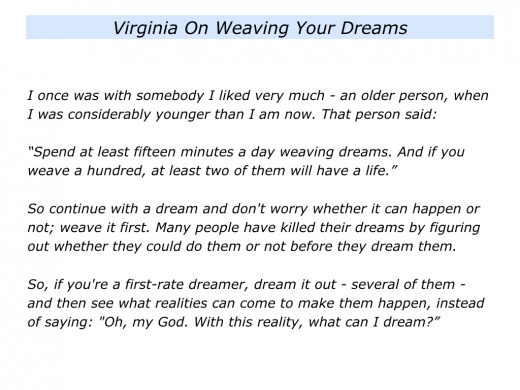
Qualifying from college, Virginia then spent several years working as a schoolteacher. Wanting to broaden her experience, she worked in different cities, including Ann Arbor, St. Louis and Miami, Florida.
Deciding to focus on social work, she began doing graduate work at Northwestern University in Chicago in 1937. Virginia studied on a part-time basis for the first few years – university in the summer, whilst doing her teaching work during the other months.
She then switched to full-time study, finishing her coursework by 1943 and her thesis by 1948. She also got married in 1941 – and divorced in 1949. More of which later.
Virginia initially found the academic side tough, but she excelled at the practice. The university culture was, to say the least, not conducive to married women who wanted to pursue a career.
Alongside the academic work, she was given a potentially nerve-wracking placement at the Chicago Home for Girls. She flourished in the environment, even without the benefit of ongoing supervision.
Virginia’s approach was considered unconventional, but it produced fine results. She would follow this path for the rest of her life.
The University of Chicago did finally recognise her gifts. In 1975 it awarded her a Gold Medal for service to humankind.
Marriages and a family
Virginia was married twice. The first marriage was to Gordon Rodgers. He was young soldier on leave when they met at a train station.
The couple lived together for a few months, but then he was dispatched to do other wartime duties. Early in their marriage, she had an entopic pregnancy, which led to an hysterectomy.
Returning after the war, both she and he felt they had grown apart. They divorced in 1949. She married her second husband, Norman Satir, in 1951 and they divorced in 1957.
Interviewed by Carol Blitzer in 1980, Virginia wondered if there had been somebody like her – a family therapist – to help, then maybe things could have worked out.
On the other hand, she wanted to roam the globe. She explained:
“I don’t see how I could have done what I’ve done in the world had I been married. It wouldn’t be fair to me, it wouldn’t be fair to the other people.
“I really feel it was a kind of destiny because I’ve been able to get to places. There are some people in the world who have other jobs to do.”
She did, however, have a family. During the time of her marriage to Gordon she started working with two young women, Mary and Ruth.
During her second marriage she formally adopted them. When publishing her book The New People Making, she dedicated it to them, writing:
“To my daughters, Mary & Ruth and their children Tina, Barry, Angela, Scott, Julie, John, and Michael, who helped to texture me.”
Virginia’s pioneering work – some
of her ideas and innovations
Virginia completed the Masters dissertation and started her own practice. Looking back on her first therapy session with a whole family in 1951, she realised the value of seeing the whole picture.
This was a time when systems theory – and seeing the whole family as a system – was coming to prominence. Previously the problem child was taken away, treated and then put back in the family. Frequently the problem child relapsed into their old behaviour.
Certainly the person must take responsibility. But there was also something in the system – such as family pain or unresolved issues – that was shifted onto the family scapegoat.
Virginia believed it was vital to help the whole family to grow. During the next decade she pioneered work on family therapy and used many innovative techniques.
Virginia taught people how to see the family as a system which had certain rules. Some rules were open, but some might be hidden; some were helpful, others might cause confusion.
The family might, for example, have rules about how people got attention. They might get it by giving clear messages, falling sick, creating problems or whatever.
She helped them to identify the rules around many topics – such as showing affection, expressing anger and managing differences. People were then able:
To see the rules.
To see the consequences these rules.
To practice the rules they wanted in the future.
Virginia also helped people to identify different communication and behavioural styles. These included:
The Leveller.
Somebody who took responsibility and gave clear messages. Later in her career Virginia used the term ‘Congruent’ – rather than ‘Leveller’ – to symbolise such clear communication.
The Placater.
Somebody who pleased others and put themselves last. For example, somebody who took the role of perfect child, later to grow-up to be a martyr.
The Blamer.
Somebody who blamed others and created arguments.
The Computer.
Somebody who was scared of expressing feelings and intellectualised emotions.
The Distracter.
Somebody who distracted, often by behaving in a problematic way.
They might do this to get attention or, for example, create a diversion to stop family conversations that were entering difficult territory.
Virginia got family members to play the different roles. This helped them to understand how each role felt and how such a person could be reached.
“People often have good intentions, but poor communication,” said Virginia.
So she enabled the family members to practice giving clear messages, rather than confused messages or conflicting messages.
Clear messages called for the person clearly expressing what they wanted to communicate. Their words, body and actions must all give the same message.
Confused messages were just that. There was so much uncertainty and camouflaging about the communication that nobody could untangle the message.
Conflicting messages – sometimes known as double messages – created difficulties. Parents might urge their 17 year-old-drug addict son to take responsibility, for example, whilst also providing pocket money the son used to buy drugs.
Virginia’s used her warmth and insight to educate people about such dynamics. Many were receptive. They felt that, at last, somebody understood their role in the family. She enabled them to create a healthier future.
Virginia spent almost four decades practicing therapy, teaching and running workshops across the world. She started implemented the family approach by herself, then co-operated with Dr. Calmest Gyros at the Illinois Psychiatric Institute.
Moving to California, she worked with Don Jackson and Jules Riskin, founding the Mental Health Research Institute in Menlo Park.
Backed by the US National Institute for Mental Health, she led the first formal training in family therapy in 1962.
The books and workshops
Virginia published her first book Conjoint Family Therapy in 1964. This was addressed to professionals and written in the form of a manual.
Therapists found it extremely useful because it contained specific guidelines, for example, on how to take a family chronology – interviewing the couple about the history of their families.
Virginia saw this as in important part of the first session, particularly when the therapist asked the couple:
“When did you first meet? Who saw who first? What did you feel then? Who made the first approach? What happened next?”
There were several aims with such questions.
To tell the story of the family’s history, especially with the children listening.
To help the couple remember – and maybe rekindle – the magic they felt when first meeting.
To then go back further into each parent’s family and understand the parental models they had when growing up.
This information provided clues about the parent’s behaviour and helped them to understand their own communication styles.
Conjoint Family Therapy was a great book for therapists. (My colleagues and I used it on the two-month long family therapy training programmes we ran in London in the early 1970s.)
Virginia was a magical teacher and put her heart and soul into her next book, however, which was called Peoplemaking. Published in 1972, it was followed by a newer version called The New Peoplemaking.
This book helped Virginia to reach a much wider audience. Full of drawings and written in a personal style, it reached people’s hearts as well as their heads.
Speaking directly to the reader, she explained the different communication styles – the Leveller, Placater, Blamer, Computer and Distracter.
She also introduced the idea of Pot – high pot or low pot – to indicate a person’s level of self-worth. (We will explore this concept later.)
Peoplemaking presented a great leap forward and many more people became aware of her work.
Virginia was now travelling far and wide. She ran workshops in America, Canada, Mexico, South America, Europe and Asia.
Her students were also spreading the word. This led to an increased demand for training and for many years she held month-long workshops in Crested Butte, Colorado.
Family sculpture
Virginia was able to move from the concept to the concrete, often bringing ideas to life in a physical way. When running workshops for therapists, she would invite a volunteer to do a family sculpture.
Let’s imagine, for example, that the volunteer had grown up as the eldest sister in a family where:
The parents were far apart.
The mother pushed herself down.
The father turned his back to the family.
The eldest sister (the volunteer who was sculpting her own family) acted as mother to the family, whilst neglecting her own needs.
The youngest sister took the role of sick child, which was maybe the only way of getting attention.
The brother sat in his room, but occasionally made contact with the eldest sister.
Choosing people from the workshop, the volunteer made a physical representation – a sculpture – of her family. While arranging the people in their appropriate positions, she talked through what was actually happening in the family.
She explained the relationships, the communications and the roles played by the parents and siblings. After explaining how the family was, the volunteer might then sculpt how she wanted it to be.
Completing the two sculptures, she would then step back and ask the actors to move from: a) how it was, to; b) how she wanted it to be. This showed the actual movements people would have needed to take to make this happen.
The family sculpture exercise could obviously be quite emotional, but it was vital for therapists to understand their own family backgrounds. They could then use this exercise with real-life families in the future.
I have seen it work superbly with troubled families. Each person – the mother, father and each child – sculpted how they saw the family at the moment. They followed by showing how they wanted it to be.
The physical movements between the two scenarios showed the possible changes people could make to create their ideal family. Virtually every family found the exercise to be helpful.
Virginia’s legacy
Virginia spent the rest of her life travelling the world, running workshops and laying the foundations for another book. She also set up several networks.
She founded The Avanta Network in 1977, which is now known as The Virginia Satir Global Network. As mentioned earlier, this is the main site covering her work, but also provides links to many other sites around the world. You can find it at:
During her final years Virginia began work on another book, called The Third Birth. She saw the first birth as when the ovum and sperm unite.
The second birth was actually coming into the world. The third birth was:
“When we become our own decision makers.”
The Third Birth was not published in finished form, but the manuscript can be found The Virginia Satir Global Network.
Virginia kept teaching but, in May 1988, experienced severe stomach pains. She continued work and began her annual workshop at Crested Butte.
One of the participants was a physician and he recommended she get medical treatment immediately as her colouring was yellow.
She agreed to see someone in Gunnison and was flown then to Stanford Hospital in Palo Alto. She was diagnosed as having pancreatic cancer which had also spread to her liver.
Virginia chose to spend her remaining months at home. She chose to pursue a nutritional approach to healing, rather than chemotherapy.
By August, however, she was feel extremely ill, and chose to rest. Margareta Suarez quotes Virginia writing the following note:
“To all my friends, colleagues and family: I send you love. Please support me in my passage to a new life. I have no other way to thank you than this.
“You have all played a significant part in my development of loving. As a result, my life has been rich and full, so I leave feeling very grateful.”
Virginia died on September 10, 1988. Following her request, she was cremated and her grave is in Mounts of Crested Butte, Colorado.
Her legacy continues to live, however, in her books, networks and the many students who practice her philosophy around the world.
Principles
Virginia pursued certain beliefs to help people grow. Today some of these seem obvious, but it is important to consider the time – and the context – within which she was working.
Bearing this in mind, let’s explore some of the key principles she followed to help people pursue their chosen paths in life.
People can be true to
themselves and grow
“Sounds obvious, of course you have to be true to yourself,” somebody may say. Agreed, but try saying that in 1975 to, for example:
The 44-year-old mother who cares for everybody else in the family, denies her own feelings and is suffering from illnesses as two of her children prepare to leave home.
The 45-year-old father who gave up his dreams to take a steady job in the steelworks to feed the family, but now the factory is closing.
The 17-year-old daughter who wants to please her parents. She has studied hard and is going to university to study Law, but she is unsure this is the right thing. Maybe she can return to her first love, music, later in life.
The 18-year-old son who fights with his father. They were closest when he played for the College football team, but have since drifted apart. He has opted to go into the army. Maybe that will bring him what he needs.
The 8-year-old-daughter who feels lonely. Always shy and in her own world, she has recently felt ill, but nobody will believe her. How can she attract people’s attention?
Virginia believed in helping people to fulfil their potential. Although she saw her job as to help relieve the family pain, she did this in a positive way.
She often began by asking the couple to relive the magic of when they first met – and then ask each family member about the best times in the family. Most of all, however, she conveyed to each person the message:
“I understand. You want the best for your loved ones – and you are doing your best.
“Sometimes it is confusing that things don’t work out how you intended. Let’s look at how to make them better.”
She provided a sense of affirmation in two ways, starting with: ‘How things are.’ She recognised the realness of people’s feelings.
Madness can result from initially believing in your own feelings, but these being ignored or, even worse, disqualified by others.
This causes panic for individuals suffering from, for example, sexual or other abuse. The person wants to cry out:
“See, I am hurting. Now you tell me I’m not. Please help.”
Virginia encouraged people to speak about their real feelings and then moved on to their aspirations: ‘How things could be.’
She helped people to build on their strengths – the life-experience they had built up, especially from the tough times – and stretch to achieve their goals.
Lynne Namka, one of Virginia’s students, came from a family where people hid their feelings. She recalls asking her:
“Virginia, do you mean you can really ask for what you want?”
She slapped her knee and said, “Honey, you can always ask for what you want!”
She added: “Say what you mean and mean what you say. Ask for what you want but know you will not always get it.”
Virginia encouraged people to be their true selves, but some found this difficult. So she helped them to express what she called The Five Freedoms.
Virginia had the ability: a) To accept and affirm what somebody was feeling; b) To enable them to take responsibility for shaping their future.
This meant acknowledging their experience, but drawing strength from it to help themselves and others, rather than dwell on it. She had both:
The first empathy.
This is empathising with the person’s actual situation. You are able to see, feel and experience the world from the person’s point of view.
The second empathy.
This is empathising with the person’s aspirations. You are able to connect with the person and give voice to their aspirations – maybe some they haven’t even thought of yet – then enable them to achieve these goals.
Virginia encouraged people to take charge of their futures. When asked by an angry fifteen-year-old girl about how she could live a fulfilling life, Virginia wrote and sent her a poem called I Am Me.
Virginia wanted people to have self knowledge, but not to be self indulgent. How to make this happen?
She believed the key lay in connecting with other people and building relationships in which everybody developed. This leads to another principle she followed in her work.
People can build enriching relationships
that enable everybody to grow
Being real was crucial – and so was building real relationships. Virginia saw the family as the crucible in which so much was formed.
She talked about the triad of mother, father and child. She said things like:
“If we can heal families, we can heal the world.”
Much of her work was done in a time when the conventional family unit was considered the norm – and she may well have developed her ideas as new forms of families evolved.
Virginia believed we all needed affection, acceptance and affirmation. This would give us the strength to adventure.
Connection was the key. She said:
“I believe the greatest gift I can conceive of having from anyone is to be seen by them, heard by them, to be understood and touched by them.
“The greatest gift I can give is to see, hear, understand and to touch another person. When this is done I feel contact has been made.”
Communication was crucial, but relationships could still go wrong. Some would be rewarding, but others might be painful.
How to recognise which were helpful and which were hurtful? How to deal with these relationships in the future?
Here is an exercise that Virginia inspired to help individuals understand their levels of self confidence.
The Self Confidence Pot
When the Pagenkopf family lived on a farm in Wisconsin, they had a giant pot in the kitchen. The pot had multiple uses, one of which was to make soup.
(Virginia tells many stories about the uses of the pot, but we will explore this one in particular.)
Returning home from school, the children wanted to know how much soup was in the pot, asking:
“Is the pot high or low?”
The terms high pot and low pot passed into their language, becoming shorthand for asking about other things. For example:
“How is your pot today?” was a quick way of asking: “How are you feeling – high or low?”
Virginia built on this idea and created many different exercises on the theme. Here is one she inspired that develops the original idea. It invites you to go through three steps.
Step 1: You can clarify your level of self confidence.
How high is your self confidence? Sometimes in our lives we feel up, sometimes we feel down. There are many reasons for this – but here is one explanation. Start by drawing an imaginary pot.
Looking at the pot, draw a line that corresponds with how high you feel your self confidence is today.
If you have high confidence, draw it high up the pot. If your confidence is low, draw it at a lower point in the pot. The next step explores why it may be at this level.
Step 2: You can clarify your pot fillers and pot drillers.
Write the names of your pot fillers. These are the people who give you encouragement and energy.
You look forward to seeing them and feel more alive after meeting them. Also, describe the things you do to give yourself energy – such as listening to music, reading, gardening or whatever.
If you have lots of things that give you positive energy, then your pot will be overflowing – and you will be more able to pass-on encouragement to other people.
But there may be complications, which brings us to the next part of the exercise.
Write the names of your pot drillers. These are people who sap energy. They leave you feeling drained and discouraged.
The more significant they are in your life, the nearer they will be to the base. You may also do things to drill holes in your own pot.
Some people may, of course, be both pot fillers and pot drillers. They may have a ‘pleasing – hurting’ pattern. Sometimes they are positive then, without warning, they lash out.
Clarify the specific things these people do to encourage or drain you.
Step 3: You can clarify how you can raise your self confidence level.
How can you raise your confidence and also encourage other people? Here are some suggestions you may wish to consider.
Spend more time with people who give you energy.
Start by spending time with your encouragers. If possible, only work with colleagues you find stimulating. People often find that, as they get older, they spend more time with personal and professional soul mates.
Encourage yourself. Do more of the things you love, for example, listening to music, skiing, visiting the theatre or whatever. Pursuing these activities will put more energy into your pot.
Spend less time – or no time – with people who drain energy.
Radical changes are difficult to make overnight but, unless the holes are filled, encouragement will simply flow out of the bottom. You can do two things with the stoppers.
Stop seeing people who drain energy.
Why take such a drastic step? Energy is life. You need pure energy, rather than poisonous energy. For example, two of the main reasons why people leave their jobs are: a) They are working for a manager who makes life difficult each day; b) They are doing work that no longer gives them a sense of fulfilment.
So they begin searching for satisfying work with a manager whom they respect.
Start making clear contracts with the people who both encourage and stop you.
Reward the positive. Give clear messages about the specific things you do like them doing. Explain how you would like to build on these parts of the relationship.
Give positive alternatives to the negative. Say: “In the future, is it possible for you to …” or “I would prefer it if you …”
Present suggestions, rather than label them as bad. Don’t expect people to respond immediately, everybody needs time to lick their wounds. Don’t argue or fall into the blame game.
What if the person refuses to respond? Then make the decision whether to stay or leave.
Be an encourager – a pot filler – for other people.
Encourage other people and they are more likely to support you. Give and give – but don’t become a victim. Do not stay around to have your pot drilled by people who choose to be miserable or observer critics.
Finally, when in doubt, ask yourself: “Is this activity giving me energy?”
If not, switch to spending time with the people – and on the activities – that provide stimulation.
Virginia enabled many people to become pot fillers rather than pot drillers and, as a result, build more enriching relationships. Taking this step often involved respecting and encouraging differences. This brings us to another principle she followed in her work.
People can build healthy systems – families, teams
and organisations – that enable people to grow
She found that healthy families demonstrated certain characteristics. Let’s explore two of the main ones.
They shared common values.
They respected and encouraged differences – obviously within certain parameters.
Sick families fought over their values and crushed differences.
Virginia here highlighted one of the key characteristics of healthy systems – be these marriages, families, teams or organisations.
Such systems are based on common values. They only flourish, however, if on top of these they also encourage variety.
Managing differences can make or break
a relationship, family or other system
Virginia believed that the way people managed their differences determined whether their relationship flourished or died.
Here is an exercise that was inspired by her approach. Although it relates to couples, the principle of managing differences successfully has been applied to many other systems, such as teams and organisations.
Imagine you are working with a couple. You can invite them to go through the following steps.
Managing Differences Successfully
– an exercise for couples
Each person makes lists of the following things.
Similarities: How my partner is similar to me.
This can cover every aspect of life. Such as values, attitudes, habits, behaviour, physical things, psychological things, philosophical things or whatever.
So somebody might list the way their partner is similar to them by writing:
“They have two children – ours; they like walking in the countryside; they get angry about injustice; they like Italian food; they enjoy watching football; they enjoy having pets; etc.”
Differences: How my partner is different from me.
This can also cover everything aspect of life. So somebody might list how their partner is different from them by writing:
“They are a morning person, while I am an evening person; they retreat into themselves, whilst I want to express my feelings; they have different standards of tidiness in the house; they drink quite a lot; they are a man, I am a woman, etc.”
Similarities: How we can build on what we have in common.
Each partner then describes how they want to build on what they have in common. Providing these are healthy similarities – things that benefit them both – it is good to build on this foundation.
People may plan, for example, to share more adventures or projects in the future.
Differences: How we can manage the differences.
This is the crunch part. Differences can make or break a relationship. They can add juiciness – or they can be a nightmare.
Each person is to take the following steps. Looking at how their partner is different from them, they are to highlight three areas:
The differences they want to encourage, because these make the other person special.
The differences they are prepared to accept, because their partner probably won’t change certain habits. Bearing in mind the whole package involved in living with their partner, they may be prepared to accept some of the differences.
The differences they would like their partner to change and how. It is vital for them to give a positive alternative.
This final point is crucial. For example: Partner A may be upset because Partner B behaves in a certain way – such as suppressing their feelings, drinking lots of alcohol, fighting dirty during arguments or whatever.
Bearing this in mind, Partner A has several options. Each option has consequences.
They can simply put up with the behaviour.
They can harangue the other person, hoping they will change.
They can give the other person a positive alternative, explaining how they would like them to behave in the future.
Let’s imagine Partner A gives the alternative, but Partner B says: “I am not prepared to change.”
Then Partner A can ask themselves: “Am I prepared to stay in the relationship? Is it worth the whole package?”
If so, fine. If not, then Partner A has a decision to make.
Virginia opened people’s eyes to the importance of managing differences successfully. This idea was picked up and used by many other people. Looking at my own work, for example, I apply it to building super teams.
Such teams are based on similarity of spirit and diversity of strengths. Diversity of spirit is a recipe for disaster.
Healthy systems – whether they are families, teams or organisations – are based on common values. These provide the foundation.
They only flourish, however, if on top of this they encourage variety. Healthy systems are therefore often based on similarity of spirit and diversity of strengths.
Practice
So what has been the effect of Virginia work? She has obviously encouraged many people – it is estimated around 30,000 people attended her workshops.
But her influence stretched much wider. Her books, such as Conjoint Family Therapy and Peoplemaking, reached a much huge audience.
Many educators and consultants embraced Virginia’s ideas – sometimes without ever knowing she had originated some of the concepts.
She also helped to found the Avanta Network, the name of which was later changed to The Virginia Satir Global Network, which embraces the following principles.
Guiding Principles
Built upon the foundation of Virginia Satir’s theory and practice, Virginia Satir Global Network’s work begins from the following assumptions:
Each of us can live in congruence with our unique selves and in harmony with others.
The potential for growth and change is inherent.
Positive evolution personally and globally is not only possible but also essential.
Virginia’s ideas continue to spread. John Banmen brought together many papers to provide an overview of her work and Sharon Loeschen wrote an excellent book called Systematic Training in the Skills of Virginia Satir.
Virginia said she wanted to be a detective that helped to solve the puzzles within families. She was much more. She rightly earned her accolade as a pioneer of family therapy. Virginia helped thousands of people to discover new and enriching worlds.
Here is another old video of Virginia in action. This also includes information about where to buy the video.


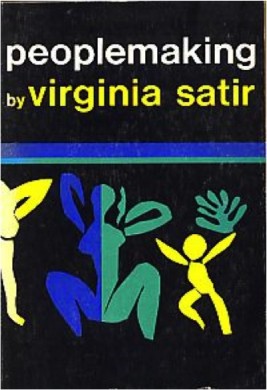
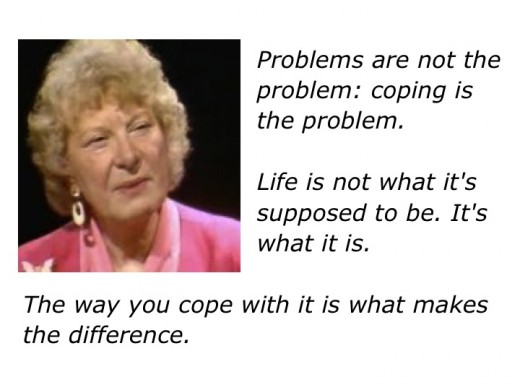
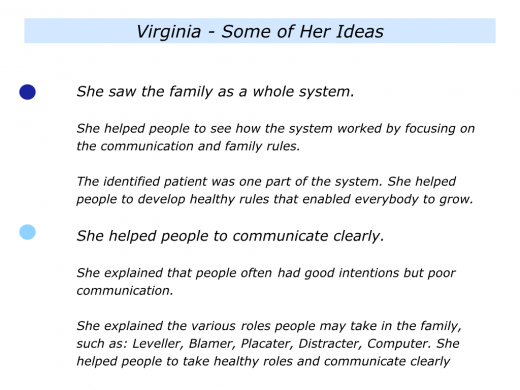
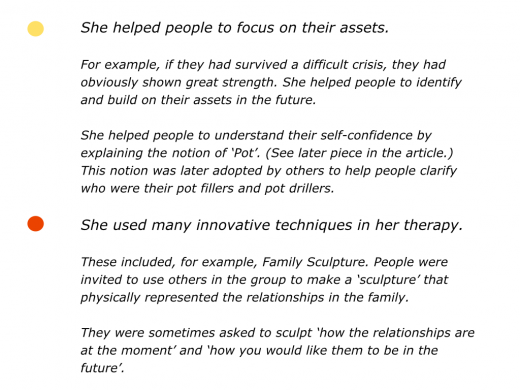
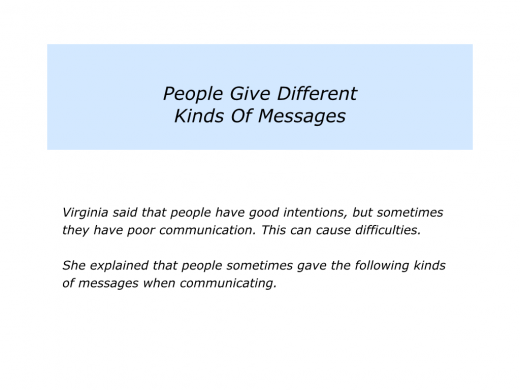
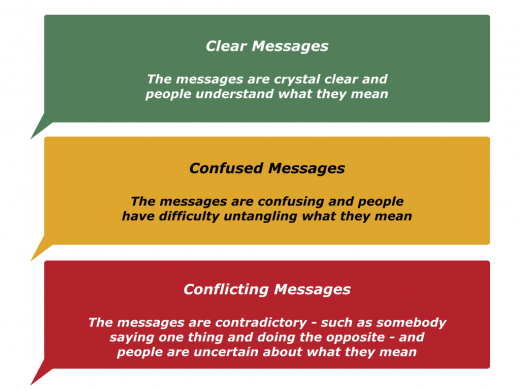
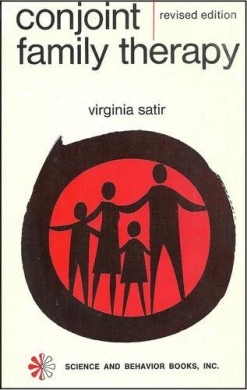
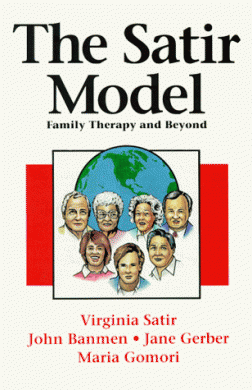
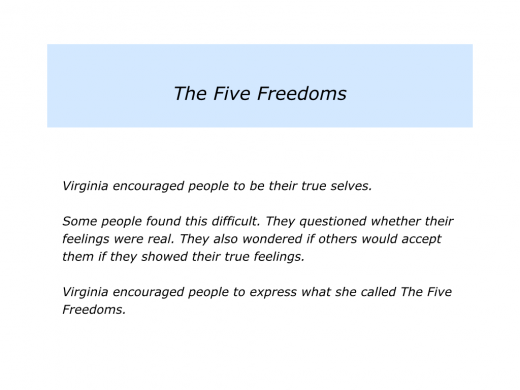
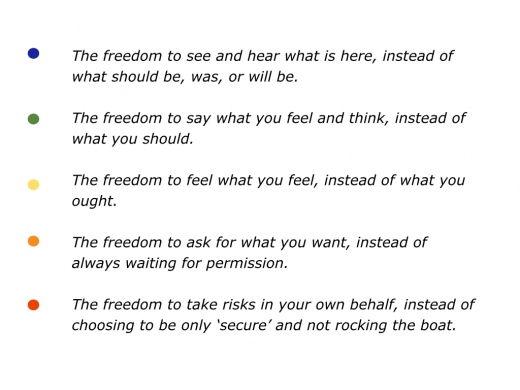
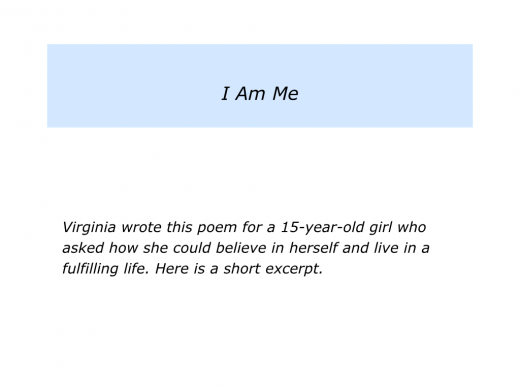
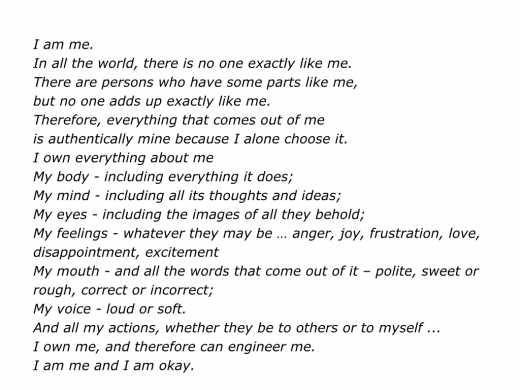
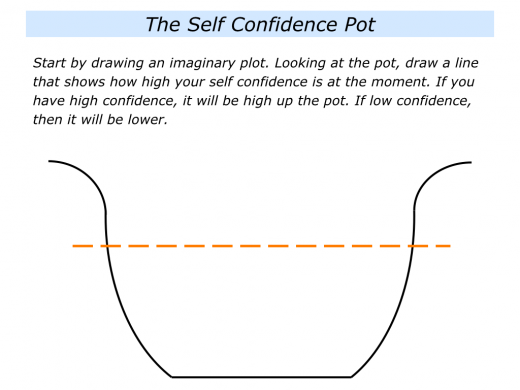
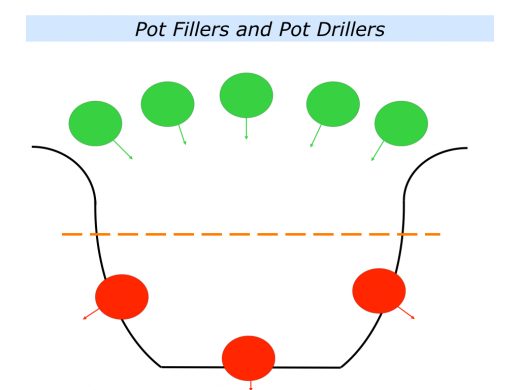
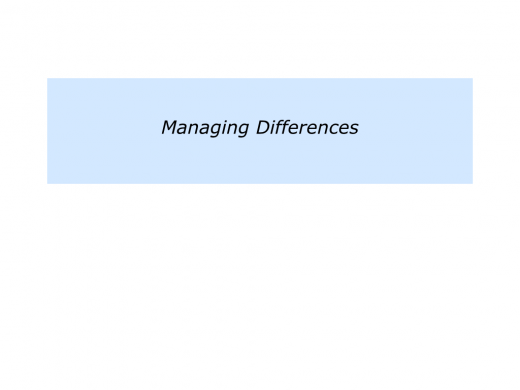
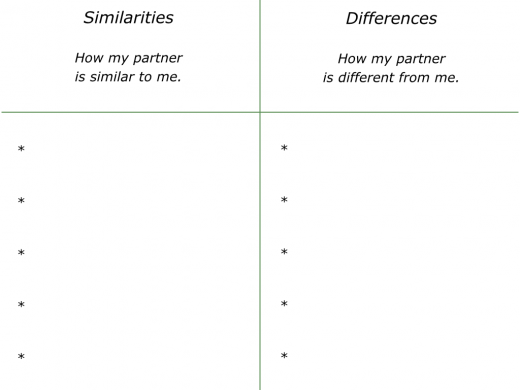
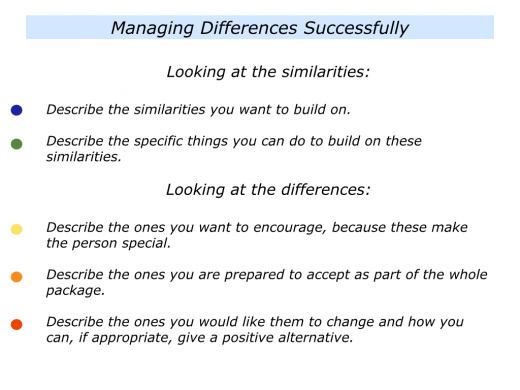
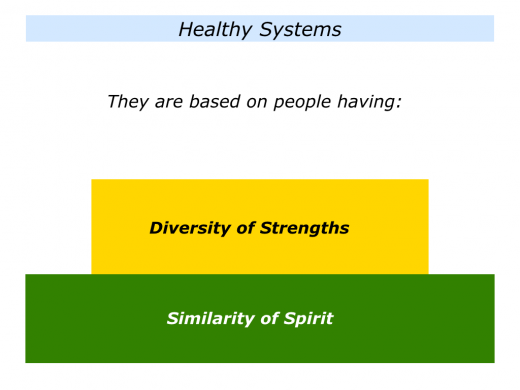




[…] Virginia Satir […]
[…] quick to be self-critical and we can be full of internal judgment. The American family therapist, Virginia Satir, reckoned that we listen to thousands of hours of what she called ‘parenting tapes’ (playing […]
Excellent combination of summary of biographical information and key concepts and teachings of Virginia Satir
I enjoyed the information. Thanks for sharing.